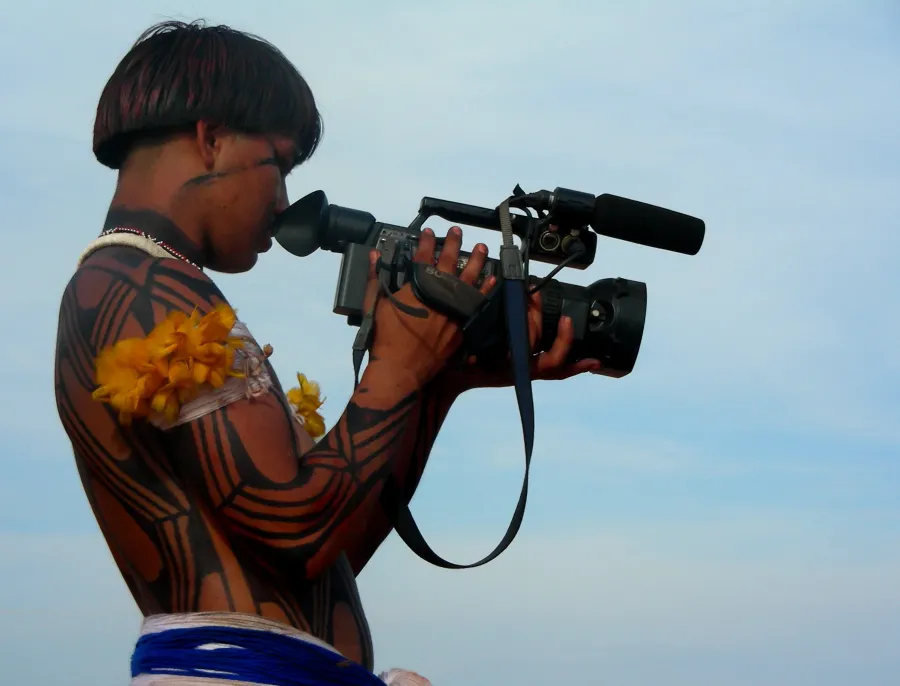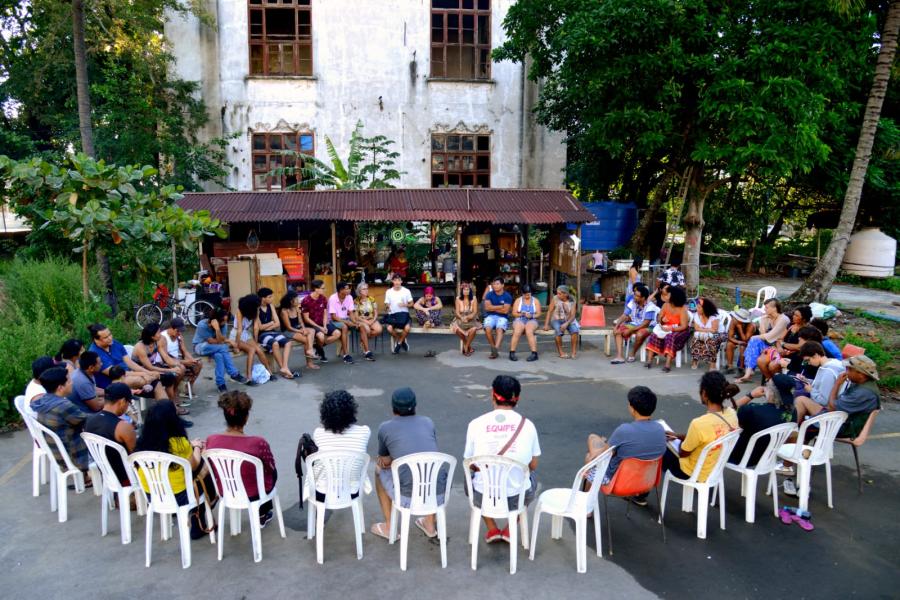
The participation of Indigenous Peoples from Brazil and their representatives at 27th Conference of the Parties to the United Nations Framework Convention on Climate Change (UNFCCC COP27), was visible in almost every space. It was encouraging to see a majority of women and youth participating as leaders and representatives. All of them would repeatedly mention one word: “demarcação,” demarcation of Indigenous Lands, bringing international attention to the grave need to demarcate Indigenous lands in Brazil. They argued that the best way to protect the environment is to let Indigenous people steward and manage it.
At COP27, Indigenous Peoples from Brazil came in a large delegation coordinated by organizations such as the Articulação dos Povos Indígenas do Brasil (APIB), a network of indigenous organizations with representation in all regions of the country; Coordenação das Organizações Indígenas da Amazônia (COIAB-Amazon Forest Coalition); and Articulação dos Povos e Organizações Indígenas do Nordeste - Minas Gerais e Espirito Santo (APOINME - Northeastern Indigenous Peoples). The event took place November 6-18, 2022 in Sharm el-Sheikh, Egypt.
I spoke to many Indigenous leaders about their expectations for the event, reasons for participating, and the challenging political situation in the country. (Listen to all of our Indigenous Rights Radio interviews with Indigenous representatives at COP27). During the Indigenous Peoples Caucus, Indigenous organizations organized to defend their rights in a global context and prepared to negotiate with representatives of the parties on the conference agenda. In recent years, Indigenous people from Brazil have gradually increased their participation in international events such as COP27, the Convention on Biological Diversity, and others.
From Fear and Violence to Hope and Visibility
Every day, Indigenous Peoples in Brazil deal with the commodification of soybeans, meat, gold, iron, and other extractable metals desired by the international market with the promise of bringing wealth to the country. However, these commodities leave a trail of negative impacts and rights violations of Indigenous Peoples. These impacts add to the environmental devastation in the country happening on a historic scale, which threaten the present and future of the world's largest tropical forest, the Floresta Amazonica (Amazon rainforest), and other important biomes of the country.
The Brazilian State invests in the exploitation of mining activities, agribusiness monoculture of soybeans and beef, and so-called “developmental enterprises” like highways and hydroelectric dams. The State’s approach has been the other important engine of destruction of the environment, Indigenous cultures, and traditional livelihoods. That is the main reason why the Brazilian State refuses to demarcate the Indigenous lands or/and fails to protect the demarcated lands.
Advancing Brazilian Indigenous Peoples’ Agenda at International Forums
For the past four years, as Cultural Survival has reported and denounced, Indigenous lands in the country have suffered an unprecedented number of invasions, illegal occupation, logging, and destruction. Led by former President Bolsonaro, who left office on December 31, 2022, the Brazilian government actively contributed to the environmental crisis in the country.
One of the main drivers of deforestation in the Amazon is the theft or illegal occupation of lands in protected areas, such as Indigenous Lands and Conservation Units. In Portuguese, this crime is called grilhagem, or land grabbing. Deforestation and fires are used to convert vast areas of primary forest into available areas for massive and mono-agricultural areas, and also to feed the huge illegal export market of timber. Not by chance, the Amazon biome region recorded the most outbreaks of fires from 2019-2022 and also had the highest rates of deforestation in the same period.
How did Bolsonaro’s government permit and promote this? By changing administrative laws and regulations, loosening permissions for mineral explorations, weakening forests and Indigenous land protection mechanisms through lowering the annual budget, and decreasing the personnel of the environmental monitoring police and other biodiversity protection agencies. All of those actions transformed the government into a criminal accomplice. Furthermore, Bolsonaro’s government did not have plans and strategies to combat crimes against the environment. In fact, the government did not consider deforestation a problem at all. It was done for the sake of “progress” and “development.”
These are the reasons why Indigenous Peoples in Brazil have intensified their presence at international events, such as COPs and UN Forums—not only to denounce those crimes, but also to make sure that the government and the world know about the importance of the demarcation of Indigenous lands to ensure biodiversity protection.
It was significant that the recently elected president of Brazil, Luiz Inácio Lula da Silva, who took office on January 1, 2023, accepted the invitation to participate at COP27 in Egypt. During that event, President Lula met with Indigenous Peoples’ representatives from various continents, and especially from Brazil, to hear about their concerns, especially about the demarcation of Indigenous lands as an essential mechanism for coping with the global climate crisis and to protect biodiversity. In front of the world and Indigenous Peoples from all continents, he promised to create a ministry for Indigenous Peoples in Brazil to work closely with environmental agencies and bodies. This promise was kept with the appointment of Sonia Guajajara (Guajajara) as the first-ever Minister of Indigenous Peoples of Brazil.
Demarcation is Key to Loss and Damage Mechanisms
As Cultural Survival reports, Loss and Damage related to climate change and environmental crisis impact Indigenous identities, cultures, languages, and livelihoods. Therefore, demarcation is not only land titling. Demarcation involves environmental, social, and economic reparation, compensation, and restoration for the losses and damage to land, biodiversity, and living conditions that the traditional territory has endured from the State's harmful colonial policies. In addition, Indigenous communities have been bearing the devastating impacts of climate change. Environmental demarcation and justification with a focus on biodiversity of which Indigenous Peoples are part is key.
To deal with loss and damage due to climate change and past and present colonialism, Indigenous Peoples in Brazil place the demarcation of land at the center of the negotiations. In practical terms, this means:
- Establishing a clear and effective demarcation process with policies to guarantee law enforcement and protection of the lands. There cannot be a full enjoyment of rights if Indigenous lands cannot be guaranteed or protected. The Indigenous lands in Brazil that have been demarcated are completely unprotected. For example, in 2022, the Yanomami completed 30 years of demarcation, but continue to suffer the most from invasions, illegal mining, violence, hunger, and lack of basic health care. During the COVID-19 pandemic in 2020 and 2021, numerous agencies reported the presence of more than 20,000 illegal prospectors on their land (Read "The Amazon is Dirty, Our Rivers and Fish are Contaminated, Everyone is Sick").
- Ensuring the full participation of Indigenous Peoples in the demarcation process. Demarcation involves transparency and recognition of Indigenous knowledge in the technical studies that are necessary for the process. Indigenous Peoples must participate in the planning, evaluation, and execution of the reports and processes. This must be broad and related to the lands' surroundings and Indigenous territories. Indigenous Peoples must be consulted about projects in the surroundings of their territories as well, because State projects like highways and hydroelectric dams bring a high risk of loss and damage to Indigenous lands and the environment. For example, the Xavante Peoples have their lands demarcated, but the monoculture of soybeans, fires, and other government projects surrounding their lands have destroyed important ecosystems and threaten the community as well as animals, plants, and fish that are part of their livelihoods. The projects weaken the demarcated lands and violate the rights of Indigenous Peoples to Free, Prior and Informed Consent (Read "A'uwư-Xavante Leaders Denounce Bogus Consultations Regarding 3 Hydroelectric Dams, Demand halt to Commercial Transport on Federal Highways during COVID).
- Including Indigenous Peoples in the protection of the environment and in the implementation of policies for the protection, compensation, and prevention of loss and damage. After the election of President Lula, the appointment of a minister for Indigenous Peoples means that the Peoples of the forest will participate in the policies of the State and the use of technical and financial public resources to protect their lands and their rights.
Demarcation means securing Indigenous Territories as sacred spaces for biocultural diversity. Indigenous territories are neither environmental reserves nor traditional community lands. They are more than that. Beyond a definition that entails the plurality of Indigenous views, it is essential to understand that Indigenous territories are not separate from Indigenous cultures, languages, ways of being, knowing, and existing in the world. Experiences with traditional communities and environmental reserves do not prevent commodification and violations of human and Indigenous rights. Pataxo Peoples in Brazil are an example of this. As discussed in a webinar hosted by Cultural Survival, Pataxo people in the northeast have faced forced removal, physical violence, and harassment. State projects and private sector investments in real estate have affected their environment, putting at risk vegetation and animals that are important for the Pataxo Peoples.
Without Indigenous Peoples, the State is incapable and other actors are unable to secure the biological and cultural integrity of the land. With a total of 62,000 square kilometers deforested in recent years, the Xingu River basin region is in a serious situation of environmental degradation. But, numerous Indigenous communities are fighting for forest regeneration in the region. In the last 10 years, seed networks from various Indigenous Peoples were responsible for the recovery of more than 7,000 hectares of degraded areas of the Xingu basin.
COP27 in Egypt, as the "COP of implementation," required everyone to return to what was decided and promised at COP26 in Glasgow, which provided a manual on how to implement the rules of the Paris Agreement from 2015. Implementation requires that resources be allocated to countries in the global South, the most vulnerable to climate change, and their most vulnerable populations. For Indigenous Peoples, the demarcation of land and its protection must be the priority of these financial resources.
As Sonia Guajajara (Guajajara), a delegate at COP27 and now the historic first Minister of Indigenous Peoples in Brazil, has been emphasizing, the political participation of Indigenous Peoples is to create and articulate public policies for Indigenous communities and manage the State budget and negotiations. “It is a form of reparation for all the denial of rights and the invisibility that exists in Brazil of the Indigenous Peoples. We are here to do something different and show that the Earth, our Mother Earth, is sacred and good, and needs care because she gives sustenance and guarantees life, the life of all. The challenge only grows, and now it is as if we return again to the beginning to resume the fight for the demarcation of the territories, which, for us, is the flag of the greater and main struggle of Indigenous Peoples.”
Top photo: Indigenous leaders at the Indigenous Caucus in Egypt 2022. Pictured in the center is Sonia Guajajara (Guajajara). Photo Edson Krenak, CS staff.


